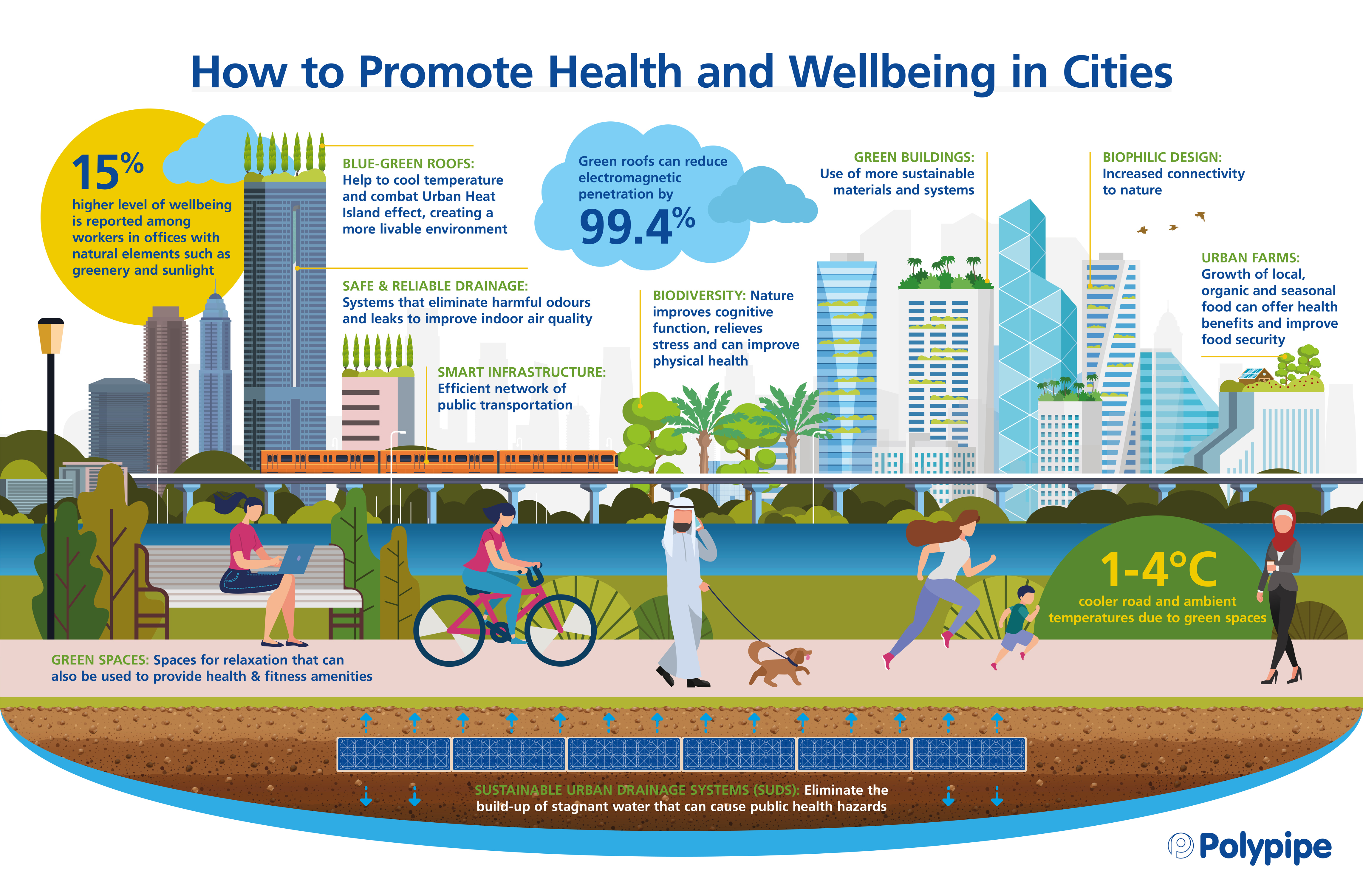5 Ways to Promote Health and Wellbeing in Cities
Tuesday 5th May 2020

The word sustainable can be defined as “to give support to” something. The concept of sustainability focuses on meeting the needs of the present in a safe and responsible way while still giving support to the needs of future generations.
The World Health Organisation (WHO) defines “a healthy city” as one that offers “a physical and built environment that supports health, recreation and wellbeing, safety, social interaction, easy mobility, a sense of pride and cultural identity, and that is accessible to the needs of all its citizens.”
The key to creating cities that promote health, wellbeing and equity is building sustainable, resilient environments that address the key pillars of sustainability – profits, planet and people.
Cities, in general, have higher population and infrastructure densities, leading to higher levels of noise and air pollution, potential overcrowding, urban heat islands and greater stress.
While this means they may pose a higher risk to physical and mental wellbeing, they are also hubs for innovation that offer better access to resources and clear economies of scale in the provision of health and other essential services.
There is a growing recognition that health and wellbeing is a collective responsibility and must be considered in a broader social context. Equity is a fundamental value in guiding policies and programs that lead to sustainable urban development.
With governments, private organisations, industry leaders and individuals all driving efforts to foster increased sustainability in urban environments, here are 5 ways to promote health, wellbeing and equity in cities:
1. Healthy Urban Environment and Eco-friendly Living
The WHO distinguishes urban environments from other environments by their primary focus being on buildings, the public realm, green spaces and transport systems.
As our cities becomes more urbanised, we become surrounded by hardscaped areas. To promote greater equity in health, city planners are increasingly implementing strategies to incorporate more green spaces that support eco-friendly living.
For example, a simple option is planting more trees! The shading provided by just 4 trees can save 25% of the energy needed for cooling a building.
Read more about how planting trees can improve wellbeing.
Humanity’s need to connect to nature runs deep. Working and living in environments removed from nature can actually exacerbate physical and mental stress.
This is where biophilic design comes in, offering principles that help to incorporate more natural elements into our spaces.
With the rising trend of ‘designing for wellness’, spaces are being enriched with natural elements such as green walls, natural woods, access to natural lighting and proximity to water.
This trend is particularly important for workspaces where it can help to improve mood, productivity and employee engagement while reducing stress levels and employee non-attendance.
2. Safe and Supportive City Mobility
Innovative urban planning can offer a citywide framework that support social and physical regeneration.
Since today’s cities are the heart of innovation and economic growth, they are becoming ‘smarter’ than ever before. We find technological innovations being increasingly incorporated into public systems to improve connectivity and enhance the quality of everyday life.
Urban areas are integrating Internet of Things (IoT) sensors and cloud-based technology to collect data and create data-driven ecosystems that provide valuable insights and help to manage assets, resources and services more efficiently.
For example, smart tools can be used to manage transportation systems, helping to monitor air quality and improve networks of public transportation, optimising the efficiency of city operations and services for citizens.
In addition to expanding business development and work opportunities, a strong and reliable public transportation system can have a variety of knock-on benefits – contributing to a healthier environment by reducing carbon emissions and improving air quality and also providing safe and efficient transport in emergency situations.
Learn more about how cities are stepping into the future.
3. Sustainable Urban Environment and Design
In order to support green urbanisation in our cities, we must encourage intersectorial collaboration to design systems that drive sustainable urban development.
At Polypipe Middle East, we live by the words, “there’s no green without blue”.
Managing Director, Adam Smith, explains, “the cause for more sustainable cities is a world-wide initiative. Intelligent water management solutions are more important than ever to support this vision.”
Water scarcity is a challenge globally, but particularly for countries in the MENA region. It is a precious resource, that if we work with, instead of against, can help to transform the way we design for the urban environment.
For example, adopting sustainable systems, such as Sustainable urban Drainage Systems (SuDS) that enable the creation of blue-green roofs can offer an eco-friendly method to reduce flooding, improve water quality, reduce Urban Heat Island effect, making cities more comfortable and livable.
By encouraging key sectors of the industry to work together, we can create systems that are more efficient, cost-effective and long-lasting that also tackle determinants of health to avoid serious public health issues and create safer spaces.
4. Caring and Supportive Environments
Caring and supportive city environments promote greater equity in health. That is why city planners are increasingly incorporating health into urban planning.
It is fundamental to design in a way that supports healthy indoor and outdoor environments, ensuring the consideration of vulnerable groups of the population such as elderly people and children.
Cities are growing vertically. Yet, as building grow taller, systems and facilities are often not properly adapted.
For example, a common problem in the region is foul odours in buildings caused by leaks and mold. These can contain toxic gases that are harmful to health, gravely affecting occupants, particularly vulnerable populations who spend more time at time.
A simple step to creating more caring and supportive environments can be integrating solutions conceived specifically for high-rise buildings to improve indoor air quality and eliminate health risks.
Learn more about improving indoor air quality in urban environments.
`
5. Healthy and Active Living
The World Health Organisation defines health as a “state of complete physical, mental and social wellbeing and not merely the absence of disease or infirmity.”
Healthy cities are not just those that prevent and reduce health risks but they are designed to promote personal wellbeing, better health and social inclusion.
With long working hours and increasingly sedentary lifestyles, city dwellers are spending more time indoors, missing out on the mental and physical benefits of exposure to nature.
Incorporating ample green spaces can provide economic (profits), environmental (planet) and social (people) benefits for property occupants and owners.
For example, the roofs of many buildings (i.e malls, parking complexes) remain unused. These spaces can be equipped with green roofs, which can then be commercialised and/or used as multifunctional spaces to provide health and fitness amenities.
Parks and gardens create a sense of culture and community. They also provide spaces for relaxation which can help citizens improve cognitive function and relieve stress.
They can even be use for urban farming to supply the fresh, seasonal and organic produce, right from the heart of the city, which in turn enhances local food security.
Explore ways how to promote health and wellbeing in our cities:

Healthier, Wealthier Cities…
It’s no doubt that health and wellbeing are becoming an increasingly prominent part of city life.
Healthy cities have an innovative role in creating environments conducive to increased health, wellbeing and equity. To progress and create these cities, we must push boundaries, develop ideas, be early adopters and create new partnerships
As sustainable practices are being more widely adopting by key industries, green building certifications such as LEED, WELL and BREEAM help to drive the growth of green urbanisation.
Early engagement is also vital. In order to create spaces that “give support to” future generations, we must design, plan, build and deliver with a forward-looking perspective.
Adam Smith, Managing Director at Polypipe Middle East, believes that “more mature economies are on the right track. There is knowledge and intent to increase sustainability, however, often the mechanism to implement it is lacking. Robust legislation and regulation are the key to encouraging sustainable development.”
Legislation, intersectorial collaboration and early engagement are all integral elements to building resiliency in our cities and creating urban environments that promote health, wellbeing and equity.
Our team of experts are on hand to explore solutions that can promote health, wellbeing and equity for your project and your community.
Tel: +971 (0) 4 518 3000
Email: middleeast@polypipe.com
